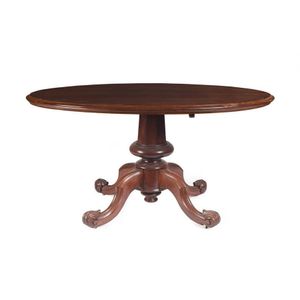Colonial Jarrah Tilt-Top Breakfast Table, c.1860-1870
You must be a subscriber, and be logged in to view price and dealer details.
Subscribe Now to view actual auction price for this item
When you subscribe, you have the option of setting the currency in which to display prices to $Au, $US, $NZ or Stg.
- Turning - Any part of a piece of furniture that has been turned and shaped with chisels on a lathe. Turned sections include legs, columns, feet, finials, pedestals, stretchers, spindles etc. There have been many varieties and fashions over the centuries: baluster, melon, barley-sugar, bobbin, cotton-reel, rope-twist, and so on. Split turning implies a turned section that has been cut in half lengthwise and applied to a cabinet front as a false decorative support.
- Jarrah - A eucalypt, known by its aboriginal name jarrah, it grows only in the south-west of Western Australia. The timber is a dark red-brown in colour with similar grain and colouring to mahogany and was used extensively in house construction as well as for making furniture.
- Platform Base - Flat-surfaced bases supporting the pedestals of dining tables and some other smaller occasional tables, including console and pier tables. Introduced during the Regency period, they continued in popularity throughout the 19th century. On tables, platform bases are usually of triform, or three-cornered shape, supported by bun, turned or carved claw feet. They may be either of veneered box-like construction, or formed from the solid timber.
- Column - An architectural feature sometimes used for decorative effect and sometimes as part of the supporting construction. Columns should generally taper slightly towards the top. They may be plain or decorated with carving, fluting or reeding. Columns may be fully rounded or, more commonly, half-rounded and attached with glue, screws or pins to the outer stiles of doors, or the facing uprights on cabinets and bureaux.
This item has been included into following indexes:
- furniture, material or decoration - jarrah 82
- tables, purpose or type
Visually similar items

A single pedestal circular breakfast table, 104 x 76 cm

A Victorian mahogany loo table, 19th century. 74 cm high, 140 cm wide, 101 cm deep

A West Australian Colonial jarrah tilt-top breakfast table, c.1880's. Maker unknown. The top comprises of figurative grained boards upon a turned central pedestal base with cabriole legs, brass castors. Height 72 cm. Diameter 109 cm

Georgian style wine table, early 20th century, with painted 'Wood-Grain' finish, with turned central column sabre leg style feet. Height 70 cm. Diameter 62 cm
